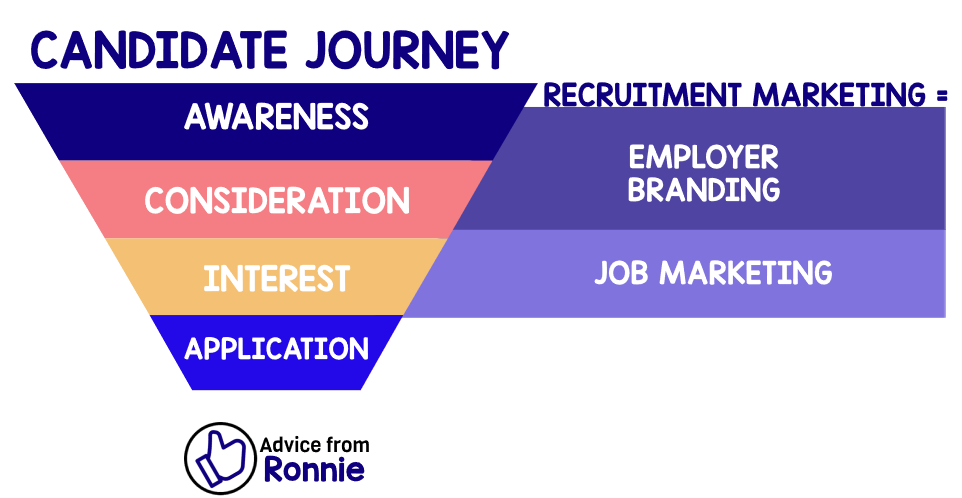As an HR and recruitment professional, do you know what goes on in the candidate’s mind when choosing a new employer? How can you meet their expectation? And how can you top it? In this blog, I provide more information about the first four steps of the candidate journey to everyone involved in recruiting new employees and, I share several tips & tricks from my own experiences.
The meaning of candidate journey.
The candidate journey is the complete journey that your candidate takes, including the onboarding phase, to join your organization. The candidate journey knows multiple contact moments or touchpoints in which you as an HR and recruitment professional can make a difference. Similarly to when buyers look for services and products to purchase, candidates go through different stages when looking for new job opportunities.
An optimal candidate journey in 7 steps


Personally, I am a big fan of the online marketing funnel with the phases Awareness, Consideration, and Interest. In Job Marketing, the funnel ends with the applicantion . The model focuses on the decision-making process.
The four phases help you take a critical look at the candidate’s decision-making process. The first four phases of the decision-making process is followed by three phases within the candidate journey, the period from hiring up to and including the first 100 days within the new position.
For this blog we focus on the first four phases of the candidate journey. Before you can build the candidate journey, you have to do some target audience research.
Know your candidate
It is important to put yourself in the position of the target audience. As soon as you know what they need, you can respond to the intrinsic motivation to choose you as an employer. To reach your candidate, you have to know on what channels they are active. When you know what to communicate, and on which channels, you’ll be able to build a lasting relationship with them. Provided that you deliver internally what you communicate externally. This way, you strive for an optimal candidate experience. Do your candidate research and create a candidate persona, it´ll make your job a lot easier!
When you know your target audience, you can start with getting their attention.
Phase 1: Awareness
The aim is to convey who you are as an employer and the distinctive character that your organization has against other employers: the Employee Value Proposition (EVP). In your employer branding strategy, a well-formulated EVP is prominent for conveying the message that you want to communicate as an employer.
Who are you as an employer and with which message do you want to address your candidates? In particular, the DNA, the values and the promises made to candidates (on- and offline). In the event that you are filling a vacancy for a client or manager, it helps you enormously to express the values of the client and the uniqueness of the vacancy. The candidate has (possibly) not yet had contact with you or your organization. After this phase it is interesting to get an answer to the question:
What has caught your attention?
You hope that the answer to this question is in line with the formulated Employee Value Proposition and that they can identify with the message. If this is structurally not the case, it is wise to go back to the drawing board with your marketing and communication colleagues to investigate where the connection with the target group is missing.
Phase 2: Consideration
Now that you have the attention of the candidate, we have arrived at the arousing part of the journey, the Consideration phase. Or as I call it, the content phase.
For the audience to consider your organization, you have to respond to what motivates or drives the (latent) target group when considering a (new) employer. This is where great content comes in place.


Content is king when you want to inform and seduce a candidate. Two things are important. Consistency and authenticity. Be consistent with the branding, the EVP message, and frequency of posting to create a recognizable employer brand. Visually and in copy. And be authentic in your storytelling. Candidates see through a beautifully packaged message, you want to be sincere.
Share content about personal development at your organization if the audience driver is personal growth. If work-life balance is important, you can share your company´s health and well-being activities. Choose the type of content that matches the preference of your audience.
Video is almost a must-have. But when attracting an older audience, written content like interviews and blogs work better. The question you want to answer after this phase is:
What piqued your interest and made you consider our organization?
When you understand the desires of your candidate, you can focus your content on the drivers of the audience. Creating a connection with your brand through inspiring and authentic content, pulling the candidate through the Consideration phase.
Phase 3: Interest
In the interest phase, it is all about getting the candidate to your vacancy.
You have the attention of the candidate, and thanks to content the candidate connects with your organization. Now it´s time to direct the candidate to the right vacancy to apply. You have to keep the momentum going and stay top of mind. Share your vacancies on the channels where your audience is active, from job boards to social media. Retarget your audience from the content phase and direct them to the vacancy on your career site. You have to keep their attention, the competition can still steal away your candidate.
Before we move on to the next phase, you want to answer the question while optimizing the journey:
What triggered you to check out our vacancy?
Phase 4: Interest
It’s finally here; the candidate has almost decided to take apply for your vacancy. The process leading up to this moment has taken a lot of time and energy. It is now up to you to ensure that the candidate takes action and applies.
You do this by writing a vacancy text that fits the journey. An attractive and honest text, where you answer the last questions and convince the candidate to apply. Give insights about salary range, type of contract and responsibilities. Never forget to conclude the vacancy text with a call-to-action and indicate which steps you will take as soon as the application has been received.
In addition, you should keep the number of clicks as low as possible within the application process. It must be easy and accessible for the candidate to apply.
Receive an application? Great! When the application has been received, make sure to follow it up as soon as possible. In this market you must act quick.It is up to you and the recruiters to make the application process as efficient and effective as possible. For this reason, you need to collect frequent feedback from the candidates to ensure that your services in all phases match the wishes of the target audience.
Optimize your candidate journey
Ask questions. Don’t make assumptions. To optimize the 4 phases of the candidate’s decision-making process, ask the following questions:
- How did you meet our organization?
- How are we as an organization known in the market?
- Where did you find our vacancy?
- Why did you apply?
- What did you think of the user-friendliness of applying for a job? (user experience)
- What did you think of the first contact with the recruiter in question?
- Through which medium do you prefer to have contact? (Whatsapp, email, Skype, etc.)

